|
Coccopygia melanotis (Swee
waxbill)
[= Estrilda melanotis]
Suidelike swie [Afrikaans]; ubuSukuswane [Zulu];
Katjikilili (applied to some of waxbills and twinspots) [Kwangali];
Xidzingirhi (generic term for firefinches and waxbills; also applied to
Ground woodpecker [check]) [Tsonga]; Groenrugastrild [Dutch]; Astrild à
joues noires [French]; Gelbbauchastrild [German]; Bico-de-lacre-meridional
[Portuguese]
Life
> Eukaryotes >
Opisthokonta
> Metazoa (animals) >
Bilateria >
Deuterostomia > Chordata >
Craniata > Vertebrata (vertebrates) > Gnathostomata (jawed
vertebrates) > Teleostomi (teleost fish) > Osteichthyes (bony fish) > Class:
Sarcopterygii (lobe-finned
fish) > Stegocephalia (terrestrial
vertebrates) > Tetrapoda
(four-legged vertebrates) > Reptiliomorpha > Amniota >
Reptilia (reptiles) >
Romeriida > Diapsida > Archosauromorpha > Archosauria >
Dinosauria
(dinosaurs) > Saurischia > Theropoda (bipedal predatory dinosaurs) >
Coelurosauria > Maniraptora >Aves
(birds) > Order: Passeriformes
> Family: Estrildidae
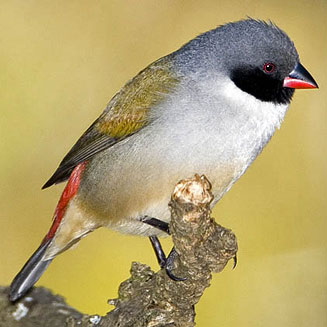 |
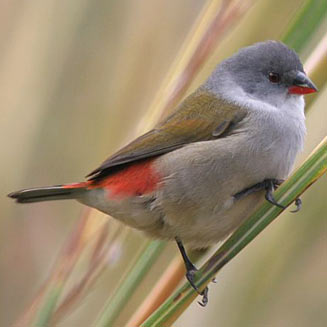 |
| Swee waxbill male. [photo
Johann Grobbelaar ©] |
Swee waxbill female, Kirstenbosch Botanical
Gardens, South Africa. [photo Trevor Hardaker ©] |
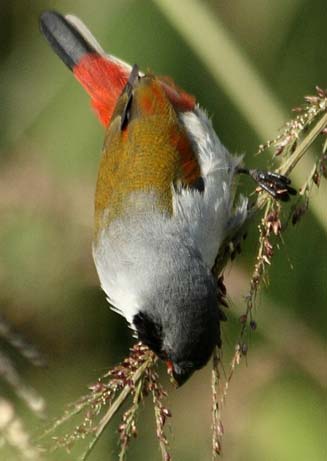 |
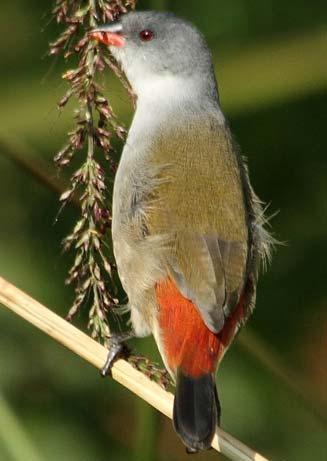 |
| Swee waxbill male (left) and female
(right) feeding on the seeds of the Setaria megaphylla
(Broad-leafed bristle Grass), Cavern Resort, KwaZulu-Natal Drakensberg,
South Africa. [photo Alan Manson
©] |
For information about this species, see
www.birdforum.net/opus/Estrilda_melanotis Distribution and habitat
Endemic to southern Africa, occurring from the Limpopo
Province south through Swaziland and the extreme south-west of Mozambique to
KwaZulu-Natal, extending east to the Eastern and Western Cape. It generally
prefers edges of montane and coastal forest, wooded valleys in fynbos, bushy
hillsides, grassy clearings in woodland, plantations and gardens.
|
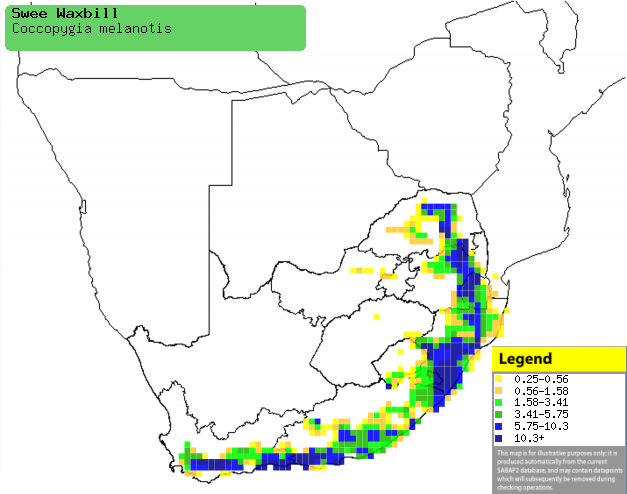 |
|
Distribution of Swee waxbill in southern Africa,
based on statistical smoothing of the records from first SA Bird Atlas
Project (©
Animal Demography unit, University of
Cape Town; smoothing by Birgit Erni and Francesca Little). Colours range
from dark blue (most common) through to yellow (least common).
See here for the latest distribution
from the SABAP2. |
Food
It mainly eats seeds taken directly from grasses,
supplemented with insects caught on the ground and in vegetation. The following food items have been recorded
in its diet:
- Plants
- Seeds
- Melinis repens (Natal redtop)
- Digitaria eriantha (Common finger grass)
- Stenotaphrum secundatum (Buffalo grass)
- Panicum maximum (Guinea grass)
- Setaria megaphylla (Broad-leafed bristle Grass)
- sedges
- thistles (Compositae)
- unripe Bidens pilosa (Common blackjack)
- buds of Buddleja (sage)
- Insects
Breeding
- The nest is built by both sexes, consisting of an oval-shaped structure
with a side-top entrance, built of dry grass and lined with soft grass
inflorescences, feathers and plant down. It is typically placed in a tree,
bush, creeper, garden pergola or Aloe, anywhere from about 2-9 metres
above ground.
- Egg-laying season is from October-April.
- It lays 3-9 eggs, although the larger clutch sizes may have been laid by
two females, which are incubated by both sexes for about 12-13 days
(recorded in captivity).
- The chicks are fed by both parents, leaving the nest after about 19-22
days, becoming fully independent about 15-19 days later (both ranges
recorded in captivity).
Threats
Not threatened, although illegal capture for cage-bird
trade is cause for concern.
References
-
Hockey PAR, Dean WRJ and Ryan PG 2005. Roberts
- Birds of southern Africa, VIIth ed. The Trustees of the John Voelcker
Bird Book Fund, Cape Town.
|
